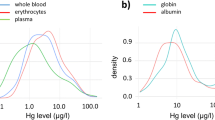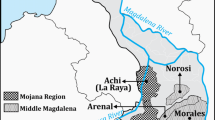Abstract
The fate of most of the Hg used to obtain Ag through amalgamation in colonial America is uncertain. Residues of this process are often unsecured, and the environmental risk they pose is frequently unknown. The aim of this study is to assess the exposure of the children population of the town of Cedral in North Central Mexico to Hg associated with uncontrolled historical amalgamation residues (tailings). Tailings were partially reprocessed in the twentieth century to obtain the remaining Ag and Hg, modifying the chemical forms of Hg in the residue and producing inorganic Hg compounds. Earlier reports show high concentrations of Hg in the soils and in the two main deposits of metallurgical waste in Cedral. A moderate level of exposure to Hg (geometric mean 3.5 µg L−1) was identified in blood samples from school-age children. A result assessment shows the importance of inhalation as a significant exposure route as well as the bioavailability of the Hg chemical form. Hg0 content in gaseous elemental mercury (GEM) reaches concentrations of up to 1793 ng m−3 in the atmosphere and, due to a low bioavailability, probably contributes only in small proportion to human exposure. Inorganic Hg compounds in the tailings generated during the reprocessing procedure are contained in the particulate fraction in the atmosphere (PM2.5; mean concentration 23.6 ng m−3) and may contribute in a higher proportion than GEM to human exposure, due to its higher bioavailability.



Similar content being viewed by others
Data Availability
Full chemical analysis results are supplied as Electronic Supplementary Material.
References
ATSDR (1999) Toxicological profile for mercury. U.S. Department of Health and Human Services. Agency for Toxic Substances and Disease Registry, Atlanta
Bargalló M (1969) La amalgamación de los minerales de plata. Compañía Fundidora de Fierro y Acero de Monterrey, Mexico City
Barregard L, Horvat M, Mazzolai B, Sällsten G, Gibicar D, Fajon V, Bona S, Munthe J, Wänberg I, Eugensson MH (2006) Urinary mercury in people living near point sources of mercury emissions. Sci Total Environ 368:326–334. https://doi.org/10.1016/j.scitotenv.2005.08.04
Chen X, Han C, Cheng H, Liu J, Xu Z, Yin X (2013) Determination of mercurial species in fish by inductively coupled plasma mass spectrometry with an ion exchange chromatographic separation. Anal Chim Acta 796:7–13. https://doi.org/10.1016/j.aca.2013.08.017
Chiprés JA, Salinas JC, Castro-Larragoitia J, Monroy MG (2008) Geochemical mapping of major and trace elements in soils from the Altiplano Potosino, Mexico: a multiscale comparison. Geochem Explor Environ Anal 8(3–4):279–290. https://doi.org/10.1144/1467-7873/08-181
Clarkson TW (2002) The three modern faces of mercury. Environ Health Perspect 110(suppl 1):11–23. https://doi.org/10.1289/ehp.02110s111
Després C, Beuter A, Richer F, Poitras K, Veilleux A, Ayotte P, Dewaillye E, Saint-Amour D, Muckle G (2005) Neuromotor functions in Inuit preschool children exposed to Pb, PCBs, and Hg. Neurotoxicol Teratol 27:245–257. https://doi.org/10.1016/j.ntt.2004.12.001
Ebinghaus R, Kock HH, Temme C, Einax JW, Löwe AG, Richter A, Burrows J, Schroeder WH (2002) Antarctic springtime depletion of atmospheric mercury. Environ Sci Technol 36:1238–1244. https://doi.org/10.1021/es015710z
Environment UN (2019) Global Mercury Assessment. UN Environment Programme-Chemicals and Health Branch, Geneva
Fisher JR (1977) Silver mines and silver miners in Colonial Peru, 1776–1824. Centre for Latin American Studies, Univ. of Liverpool, Liverpool
Fu X, Feng X, Qiu G, Shang L, Zhang H (2011) Speciated atmospheric mercury and its potential source in Guiyang, China. Atmos Environ 45:4205–4212. https://doi.org/10.1016/j.atmosenv.2011.05.012
González-Grijalva MD (2009) Evolución espacio-temporal de la calidad del agua subterránea en el acuífero Cedral-Matehuala: alternativas de uso. MSc Thesis Universidad Autónoma de San Luis Potosí. Available at https://ninive.uaslp.mx/xmlui/bitstream/handle/i/3557/MCA1EVO00901.pdf?sequence=3. Accessed 07 July 2020
Goulle JP, Le Roux P, Castanet M, Mahieu L, Guyet-Job S, Guerbet M (2015) Metallic profile of whole blood and plasma in a series of 99 healthy children. J Anal Toxicol 39:707–713. https://doi.org/10.1093/jat/bkv088
INEGI (2010) Censo de Población y Vivienda 2010. Instituto Nacional de Estadística, Geografía e Informática México, Aguascalientes City
Jaishankar M, Tseten T, Anbalagan N, Mathew BB, Beeregowda KN (2014) Toxicity, mechanism and health effects of some heavy metals. Interdiscip Toxicol 7:60–72. https://doi.org/10.2478/intox-2014-0009
Lacerda LD (1997) Global mercury emissions from gold and silver mining. Water Air Soil Pollut 97:209–221. https://doi.org/10.1023/A:1018372505344
Lacerda LD, Solomons W (1998) Mercury from gold and silver mining: a chemical time bomb? Springer, Berlin
Leura-Vicencio AK (2017) Geoquímica ambiental del mercurio en pasivos ambientales mineros metalúrgicos. Ph.D. Thesis, Universidad Autónoma de San Luis Potosí, Mexico. Available at http://ninive.uaslp.mx/xmlui/handle/i/4332
Leura-Vicencio AK, Carrizales-Yañez L, Razo-Soto I (2017) Mercury pollution assessment of mining wastes and soils from former silver amalgamation area in north-central Mexico. Rev Int de Contam Ambient 33:655–669. https://doi.org/10.20937/RICA.2017.33.04.09
Li P, Feng XB, Qiu GL, Shang LH, Li ZG (2009) Mercury pollution in Asia: a review of the contaminated sites. J Hazard Mater 168:591–601. https://doi.org/10.1016/j.jhazmat.2009.03.031
Li P, Feng X, Yuan X, Chan HM, Qiu G, Sun GX, Zhu YG (2012) Rice consumption contributes to low level methylmercury exposure in southern China. Environ Int 49:18–23. https://doi.org/10.1016/j.envint.2012.08.006
Li P, Li Y, Feng X (2016) Mercury and selenium interactions in human blood in the Wanshan mercury mining area, China. Sci Total Environ 573:376–381. https://doi.org/10.1016/j.scitotenv.2016.08.098
Lindberg S, Bullock R, Ebinghaus R, Engstrom D, Feng X et al (2007) A synthesis of progress and uncertainties in attributing the sources of mercury in deposition. Ambio 36:19–33. https://doi.org/10.2307/4315781
Lundh T, Axmon A, Skerfving S, Broberg K (2016) Cadmium and mercury exposure over time in Swedish children. Environ Res 150:600–605. https://doi.org/10.1016/j.envres.2016.02.016
Morton-Bermea O, Jiménez-Galicia RG, Castro-Larragoitia J, Hernández-Álvarez E, Pérez-Rodríguez R, García-Arreola ME, Gavilán-Garcia I, Segovia N (2015) Anthropogenic impact of the use of Hg in mining activities in Cedral SLP Mexico. Environ Earth Sci 74:1161–1168. https://doi.org/10.1007/s12665-015-4102-7
Morton-Bermea O, Garza-Galindo R, Hernández-Álvarez E, Ordoñez-Godínez S, Amador-Muñoz O, Beramendi-Orosco L, Miranda J, Rosas-Pérez I (2018) Atmospheric -1 mercury in the metropolitan area of Mexico City. Bull Environ Contam Toxicol 100:588–592. https://doi.org/10.1007/s00128-018-2288-6
National Research Council (2000) Toxicological effects of methylmercury. National Academy Press, Washington, D.C.
Nielsen JB, Grandjean GP (2000) Mercury. In: Lippmann M (ed) Environmental toxicants: human exposure and their health effects. Wiley, New York, pp 563–576
Nisse C, Tagne-Fotso R, Howsam M, Richeval C, Labat L, Leroyer A (2017) Blood and urinary levels of metals and metalloids in the general adult population of Northern France: the IMEPOGE study, 2008–2010. Int J Hyg Environ Health 220(2):341–363. https://doi.org/10.1016/j.ijheh.2016.09.020
Nriagu JO (1994) Mercury pollution from the past mining of gold and silver in the Americas. Sci Total Environ 149:167–181. https://doi.org/10.1016/0048-9697(94)90177-5
Ogura T, Ramírez-Ortiz J, Arroyo-Villaseñor ZM, Martínez SH, Palafox-Hernández JP, De Alba LHG, Fernando Q (2003) Zacatecas (Mexico) companies extract Hg from surface soil contaminated by ancient mining industries. Water Air Soil Pollut 148:167–177. https://doi.org/10.1023/A:1025497726115
Pan S, Lin L, Zeng F, Zhang J, Dong G, Yang B, Jing Y, Zhang G, Ma SGH (2018) Effects of lead, cadmium, arsenic, and mercury co-exposure on children’s intelligence quotient in an industrialized area of southern China. Environ Pollut 235:47–54. https://doi.org/10.1016/j.envpol.2017.12.044
Pronczuk-Garbino J (2005) Children’s health and the environment: a global perspective—a resource manual for the health sector. World Health Organization, Geneva
Rice KM, Walker EM Jr., Wu M, Gillette C, Blough ER (2014) Environmental mercury and its toxic effects. J Prev Med Public Health 47:74–83. https://doi.org/10.3961/jpmph.2014.47.2.74
Risher JF, Nickle RA, Amler SN (2003) Elemental mercury poisoning in occupational and residential settings. Int J Envir Heal 206(4–5):371–379. https://doi.org/10.1078/1438-4639-00233
Rolinson JM, Landing WM, Luke W, Cohen M, Salters VJM (2013) Isotopic composition of species-specific atmospheric Hg in a coastal environment. Chem Geol 336:37–49. https://doi.org/10.1016/j.chemgeo.2012.10.007
Santos EO, Jesus IMD, Câmara VDM, Brabo EDS, Jesus MID, Fayal KF, Asmus CIRF (2007) Correlation between blood mercury levels in mothers and newborns in Itaituba, Pará State, Brazil. Cuadernos de saude publica 23:S622–S629
Schober SE, Sinks TH, Jones RL et al (2003) Blood mercury levels in US children and women of childbearing Age, 1999–2000. JAMA 289(13):1667–1674. https://doi.org/10.1001/jama.289.13.1667
Schroeder WH, Yarwood G, Niki H (1991) Transformation processes involving mercury species in the atmosphere-results from a literature survey. Water Air Soil Pollut 56:653–666. https://doi.org/10.1007/BF00342307
SEMARNAT (2007) Norma Oficial Mexicana NOM-147 SEMARNAT/SSA1-2004, que establece criterios para determinar las concentraciones de remediación de suelos contaminados por arsénico, bario, berilio, cadmio, cromo hexavalente, mercurio, níquel, plata, plomo, selenio, talio y/o vanadio. Diario Oficial de la Federación, México
Sholupov S, Pogarev S, Ryzhov V, Mashyanov N, Stroganov A (2004) Zeeman atomic absorption spectrometer RA-915+ for direct determination of mercury in air and complex matrix samples. Fuel Process Technol 85:473–485. https://doi.org/10.1016/j.fuproc.2003.11.003
Slemr F, Seiler W, Schuster G (1981) Latitudinal distribution of Mercury over the Atlantic Ocean. J Geophys Res Solid Earth 86:1159–1166. https://doi.org/10.1029/JC086iC02p01159
SMN (2020) Normales Climatológicas. Período 1951–2010. Estación 24007 Normal del Desierto [online]. Available at https://smn.conagua.gob.mx/tools/RESOURCES/Normales5110/NORMAL24007.TXT. Accessed 10 Aug 2020.
Sprovieri F, Hedgcock IM, Pirrone N (2010) An investigation of the origins of reactive gaseous mercury in the Mediterranean marine boundary layer. Atmos Chem Phys 10:3985–3997. https://doi.org/10.5194/acp-10-3985-2010
SSA (2002) Norma Oficial Mexicana NOM-199-SSA1–2000, Salud ambiental. Niveles de plomo en sangre y acciones como criterios para proteger la salud de la población expuesta no ocupacionalmente. Available at https://www.dof.gob.mx/nota_detalle.php?codigo=751988&fecha=18/10/2002. Accessed 16 Aug 2020
Travnickov O (2005) Contribution of the intercontinental atmospheric transport to mercury pollution in the Northern Hemisphere. Atmos Environ 39:541–7548. https://doi.org/10.1016/j.atmosenv.2005.07.066
UNEP (2002) Global mercury assessment. Geneva United Nations Environment Programme. Available at https://wedocs.unep.org/bitstream/handle/20.500.11822/27579/GMA2018.pdf?sequence=1&isAllowed=y
WHO (2000) Air quality guidelines for Europe, vol 91, 2nd edn. European Series Geneva: WHO Regional Publications, Geneva, pp 157–162
WHO (2003) Concise international chemical assessment document, elemental mercury and inorganic mercury compounds: human health aspects. WHO, Geneva, p 68p
Acknowledgements
Partial results of the research have been integrated into the graduate thesis of Angel Alberto Arellano Álvarez, Adriana Ortíz Servín, Rebeca Yasmín Pérez-Rodríguez, Adriana Leura-Vicencio whom we thank for the contribution to the project. Thanks to Isidro Montes-Ávila for drawing Figure 1, to Utz Kramar for analytical support by the EDXRF analysis and to Sara Ordoñez Godínez by the ICP-MS analysis. This research received a partial support from DGAPA (Dirección General de Personal Académico, Universidad Nacional Autónoma de México) Project IN105520.
Funding
This research received a partial support from DGAPA (Dirección General de Personal Académico, Universidad Nacional Autónoma de México) Project IN105520.
Author information
Authors and Affiliations
Contributions
JC-L: Conceptualization, Writing—Review & Editing visualization. OM-B: Investigation Writing—Original Draft. ÁAA-Á: Investigation Formal Analysis. RYP-R: Investigation Formal analysis. AL-V: Formal Investigation Analysis. BS: Review & Editing visualization, Data curation. ES.R: Review & Editing visualization, Data curation. IR-S: Conceptualization, Supervision. EH-Á: Methodology, Validation.
Corresponding author
Ethics declarations
Conflict of interest
The authors declare that they have no conflict of interest.
Ethical Approval
Blood sampling was carried out according the Mexican regulation established in NOM-199-SSA1-2000 (SSA 2002), after validation by the bioethics committee of the Autonomous University of San Luis Potosí. Analysis.
Additional information
Publisher's Note
Springer Nature remains neutral with regard to jurisdictional claims in published maps and institutional affiliations.
Supplementary Information
Below is the link to the electronic supplementary material.
Rights and permissions
About this article
Cite this article
Morton Bermea, O., Castro-Larragoitia, J., Arellano Álvarez, Á.A. et al. Mercury in Blood of Children Exposed to Historical Residues from Metallurgical Activity. Expo Health 13, 281–292 (2021). https://doi.org/10.1007/s12403-021-00382-z
Received:
Revised:
Accepted:
Published:
Issue Date:
DOI: https://doi.org/10.1007/s12403-021-00382-z




